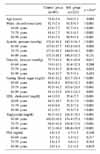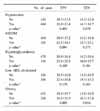Abstract
Purpose
To evaluate the relationship between factors of metabolic syndrome (MS) to prostate volume and lower urinary tract symptom in men over sixties.
Materials and Methods
A total of 624 male subjects aged 60 to 90 years were enrolled. Prostate volume, urinary flow rate, voided volume, post void residual urine volume, voiding symptoms and MS-related parameters were investigated. Patients were divided into two groups; those with MS (n=223) and those without (n=401). Prostate volume, urodynamic factors and voiding symptoms were compared based upon MS categories.
Results
The MS and control group showed no significant differences with respect to age (74.8±5.6 vs. 74.0±5.4, respectively, p=0.083) and prostate specific antigen levels (1.8±1.5 vs. 1.7±1.5, respectively, p=0.248). However, the MS group had significantly greater waist circumference, blood pressure, fasting blood sugar level, hypertriglyceridemia and lower high density lipoprotein (HDL) cholesterol than the control group (p<0.05). Patients with MS showed significantly larger total prostate volume (p=0.008) and transitional zone volume (p=0.012). There were no differences between two groups respect to maximum flow rate, voided volume and residual volume (p>0.05). There was a significant relationship between prostate volume and obesity (p=0.016), however other MS factors such as low HDL, hypertension, non-insulin dependent diabetes mellitus and hypertriglyceridemia were not associated with prostate volume (p>0.05).
Figures and Tables
Table 1
Comparisons of metabolic factors between metabolic syndrome group and control group according to age groups

Table 2
Comparison of prostate-related symptoms and prostate volume between metabolic syndrome group and control group

References
1. Rhew HY, Koo JH, Cho SS, Kang JS, Lee CK, Kim JC, et al. The prevalence of BPH in Busan city over age 40. Korean J Urol. 2001. 42:223–227.
2. Chung TG, Chung J, Lee MS, Ahn H. Prevalence of benign prostatic hyperplasia in Jeong-Eup area: community-based study. Korean J Urol. 1999. 40:52–58.
3. Lee HL, Seo JW, Kim WJ. The prevalence of benign prostatic hyperplasia: community-based study in Chungbuk province. Korean J Urol. 1999. 40:1500–1505.
4. Hammarsten J, Hogstedt B. Hyperinsulinaemia as a risk factor for developing benign prostatic hyperplasia. Eur Urol. 2001. 39:151–158.
5. Hammarsten J, Hogstedt B, Holthuis N, Mellstrom D. Components of the metabolic syndrome-risk factors for the development of benign prostatic hyperplasia. Prostate Cancer Prostatic Dis. 1998. 1:157–162.
6. Ozden C, Ozdal OL, Urgancioglu G, Koyuncu H, Gokkaya S, Memis A. The correlation between metabolic syndrome and prostatic growth in patients with benign prostatic hyperplasia. Eur Urol. 2007. 51:199–203.
7. Gupta A, Gupta S, Pavuk M, Roehrborn CG. Anthropometric and metabolic factors and risk of benign prostatic hyperplasia: a prospective cohort study of Air Force veterans. Urology. 2006. 68:1198–1205.
8. Meigs JB, Mohr B, Barry MJ, Collins MM, McKinlay JB. Risk factors for clinical benign prostatic hyperplasia in a community-based population of healthy aging men. J Clin Epidemiol. 2001. 54:935–944.
9. Giovannucci E, Rimm EB, Chute CG, Kawachi I, Colditz GA, Stampfer MJ, et al. Obesity and benign prostatic hyperplasia. Am J Epidemiol. 1994. 140:989–1002.
10. Lee S, Min HG, Choi SH, Kim YJ, Oh SW, Kim YJ, et al. Central obesity as a risk factor for prostatic hyperplasia. Obesity (Silver Spring). 2006. 14:172–179.
11. Zhuang TN, Ly LP, Cumming RG, Handelsman DJ. Growth and development during early manhood as determinants of prostate size in later life. J Clin Endocrinol Metab. 2005. 90:6055–6063.
12. Kim JH, Shim BS, Hong YS. The relating factors of metabolic syndrome to benign prostatic hyperplasia. Korean J Urol. 2005. 46:1046–1050.
13. Kim JH, Shim BS, Kim JS, Hon YS. Voiding dysfunction of men is associated with metabolic syndrome. Korean J Urol. 2006. 47:257–262.
14. Sohn JC, Chang HS, Kim CI. The correlation between metabolic syndrome and the prostate volume. Korean J Urol. 2007. 48:603–607.
15. Ku JH, Ahn JO, Lee CH, Lee NK, Park YH, Byun SS, et al. Distribution of serum prostate-specific antigen in healthy Korean men: influence of ethnicity. Urology. 2002. 60:475–479.
16. Kwon NS, Jo MK, Park K. The relationship between the metabolic syndrome and the risk of benign prostatic hyperplasia: a hospital-based study from a health screening population. Korean J Urol. 2007. 48:1016–1021.
17. Timme TL, Truong LD, Merz VW, Krebs T, Kadmon D, Flanders KC, et al. Mesenchymal-epithelial interactions and transforming growth factor-beta expression during mouse prostate morphogenesis. Endocrinology. 1994. 134:1039–1045.
18. Reaven GM. Banting lecture 1988. Role of insulin resistance in human disease. 1988. Nutrition. 1997. 13:65.
19. Ford ES. Prevalence of the metabolic syndrome defined by the International Diabetes Federation among adults in the U.S. Diabetes Care. 2005. 28:2745–2749.
20. Lim S, Park KS, Lee HK, Cho SI. Changes in the characteristics of metabolic syndrome in Korea over the period 1998-2001 as determined by Korean National Health and Nutrition Examination Surveys. Diabetes Care. 2005. 28:1810–1812.
21. Landsberg L. Diet, obesity and hypertension: an hypothesis involving insulin, the sympathetic nervous system, and adaptive thermogenesis. Q J Med. 1986. 61:1081–1090.
22. Glasser DB, Carson C 3rd, Kang JH, Laumann EO. Prevalence of storage and voiding symptoms among men aged 40 years and older in a US population-based study: results from the Male Attitudes Regarding Sexual Health study. Int J Clin Pract. 2007. 61:1294–1300.
23. Dahle SE, Chokkalingam AP, Gao YT, Deng J, Stanczyk FZ, Hsing AW. Body size and serum levels of insulin and leptin in relation to the risk of benign prostatic hyperplasia. J Urol. 2002. 168:599–604.
24. Burke JP, Rhodes T, Jacobson DJ, McGree ME, Roberts RO, Girman CJ, et al. Association of anthropometric measures with the presence and progression of benign prostatic hyperplasia. Am J Epidemiol. 2006. 164:41–46.
25. Zucchetto A, Tavani A, Dal Maso L, Gallus S, Negri E, Talamini R, et al. History of weight and obesity through life and risk of benign prostatic hyperplasia. Int J Obes (Lond). 2005. 29:798–803.
26. Michel MC, Heemann U, Schumacher H, Mehlburger L, Goepel M. Association of hypertension with symptoms of benign prostatic hyperplasia. J Urol. 2004. 172:1390–1393.




 PDF
PDF ePub
ePub Citation
Citation Print
Print





 XML Download
XML Download